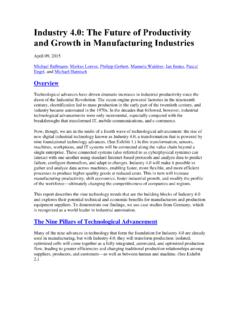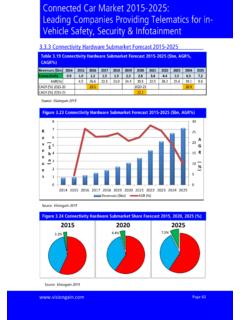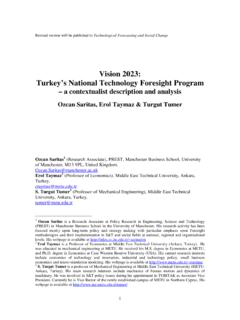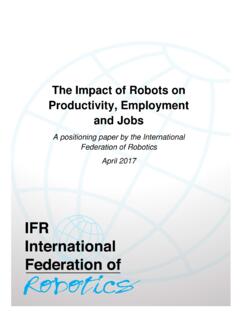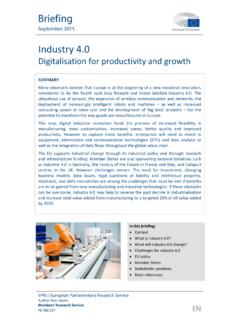Transcription of Industry 4.0: The Future of Productivity and Growth in ...
1 Industry : The Future of Productivity and Growth in Manufacturing Industries April 09, 2015 Michael R mann, Markus Lorenz, Philipp Gerbert, Manuela Waldner, Jan Justus, Pascal Engel, and Michael Harnisch Overview Technological advances have driven dramatic increases in industrial Productivity since the dawn of the Industrial Revolution. The steam engine powered factories in the nineteenth century, electrification led to mass production in the early part of the twentieth century, and Industry became automated in the 1970s. In the decades that followed, however, industrial technological advancements were only incremental, especially compared with the breakthroughs that transformed IT, mobile communications, and e-commerce. Now, though, we are in the midst of a fourth wave of technological advancement: the rise of new digital industrial technology known as Industry , a transformation that is powered by nine foundational technology advances.
2 (See Exhibit 1.) In this transformation, sensors, machines, workpieces, and IT systems will be connected along the value chain beyond a single enterprise. These connected systems (also referred to as cyberphysical systems) can interact with one another using standard Internet-based protocols and analyze data to predict failure, configure themselves, and adapt to changes. Industry will make it possible to gather and analyze data across machines, enabling faster, more flexible, and more efficient processes to produce higher-quality goods at reduced costs. This in turn will increase manufacturing Productivity , shift economics, foster industrial Growth , and modify the profile of the workforce ultimately changing the competitiveness of companies and regions. This report describes the nine technology trends that are the building blocks of Industry and explores their potential technical and economic benefits for manufacturers and production equipment suppliers.
3 To demonstrate our findings, we use case studies from Germany, which is recognized as a world leader in industrial automation. The Nine Pillars of Technological Advancement Many of the nine advances in technology that form the foundation for Industry are already used in manufacturing, but with Industry , they will transform production: isolated, optimized cells will come together as a fully integrated, automated, and optimized production flow, leading to greater efficiencies and changing traditional production relationships among suppliers, producers, and customers as well as between human and machine. (See Exhibit 2.) 2 Big Data and Analytics Analytics based on large data sets has emerged only recently in the manufacturing world, where it optimizes production quality, saves energy, and improves equipment service.
4 In an Industry context, the collection and comprehensive evaluation of data from many different 3 sources production equipment and systems as well as enterprise- and customer-management systems will become standard to support real-time decision making. For instance, semiconductor manufacturer Infineon Technologies has decreased product failures by correlating single-chip data captured in the testing phase at the end of the production process with process data collected in the wafer status phase earlier in the process. In this way, Infineon can identify patterns that help discharge faulty chips early in the production process and improve production quality. Autonomous Robots Manufacturers in many industries have long used robots to tackle complex assignments, but robots are evolving for even greater utility.
5 They are becoming more autonomous, flexible, and cooperative. Eventually, they will interact with one another and work safely side by side with humans and learn from them. These robots will cost less and have a greater range of capabilities than those used in manufacturing today. For example, Kuka, a European manufacturer of robotic equipment, offers autonomous robots that interact with one another. These robots are interconnected so that they can work together and automatically adjust their actions to fit the next unfinished product in line. High-end sensors and control units enable close collaboration with humans. Similarly, industrial-robot supplier ABB is launching a two-armed robot called YuMi that is specifically designed to assemble products (such as consumer electronics) alongside humans. Two padded arms and computer vision allow for safe interaction and parts recognition.
6 Simulation In the engineering phase, 3-D simulations of products, materials, and production processes are already used, but in the Future , simulations will be used more extensively in plant operations as well. These simulations will leverage real-time data to mirror the physical world in a virtual model, which can include machines, products, and humans. This allows operators to test and optimize the machine settings for the next product in line in the virtual world before the physical changeover, thereby driving down machine setup times and increasing quality. For example, Siemens and a German machine-tool vendor developed a virtual machine that can simulate the machining of parts using data from the physical machine. This lowers the setup time for the actual machining process by as much as 80 percent.
7 Horizontal and Vertical System Integration Most of today s IT systems are not fully integrated. Companies, suppliers, and customers are rarely closely linked. Nor are departments such as engineering, production, and service. Functions from the enterprise to the shop floor level are not fully integrated. Even engineering itself -from products to plants to automation- lacks complete integration. But with Industry , companies, departments, functions, and capabilities will become much more cohesive, as cross-company, universal data-integration networks evolve and enable truly automated value chains. For instance, Dassault Syst mes and BoostAeroSpace launched a collaboration platform for the European aerospace and defense Industry . The platform, AirDesign, serves as a common 4 workspace for design and manufacturing collaboration and is available as a service on a private cloud.
8 It manages the complex task of exchanging product and production data among multiple partners. The Industrial Internet of Things Today, only some of a manufacturer s sensors and machines are networked and make use of embedded computing. They are typically organized in a vertical automation pyramid in which sensors and field devices with limited intelligence and automation controllers feed into an overarching manufacturing-process control system. But with the Industrial Internet of Things, more devices sometimes including even unfinished products will be enriched with embedded computing and connected using standard technologies. This allows field devices to communicate and interact both with one another and with more centralized controllers, as necessary. It also decentralizes analytics and decision making, enabling real-time responses.
9 Bosch Rexroth, a drive-and-control-system vendor, outfitted a production facility for valves with a semiautomated, decentralized production process. Products are identified by radio frequency identification codes, and workstations know which manufacturing steps must be performed for each product and can adapt to perform the specific operation. Cybersecurity Many companies still rely on management and production systems that are unconnected or closed. With the increased connectivity and use of standard communications protocols that come with Industry , the need to protect critical industrial systems and manufacturing lines from cybersecurity threats increases dramatically. As a result, secure, reliable communications as well as sophisticated identity and access management of machines and users are essential.
10 During the past year, several industrial-equipment vendors have joined forces with cybersecurity companies through partnerships or acquisitions. The Cloud Companies are already using cloud-based software for some enterprise and analytics applications, but with Industry , more production-related undertakings will require increased data sharing across sites and company boundaries. At the same time, the performance of cloud technologies will improve, achieving reaction times of just several milliseconds. As a result, machine data and functionality will increasingly be deployed to the cloud, enabling more data-driven services for production systems. Even systems that monitor and control processes may become cloud based. Vendors of manufacturing-execution systems are among the companies that have started to offer cloud-based solutions.
